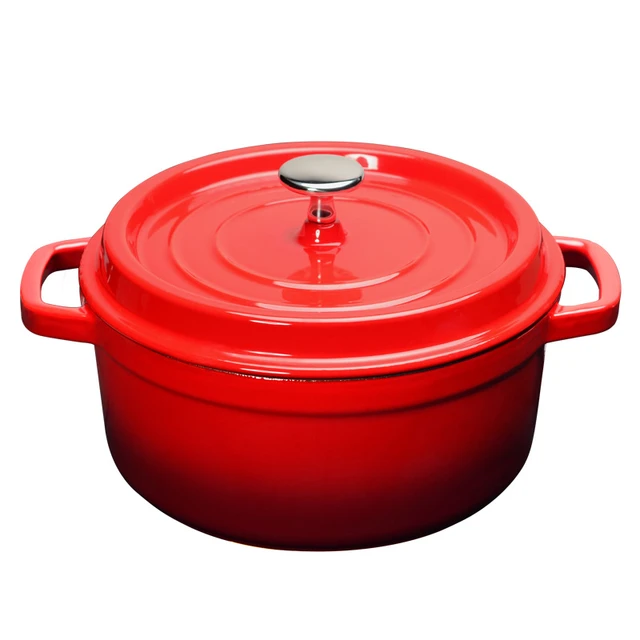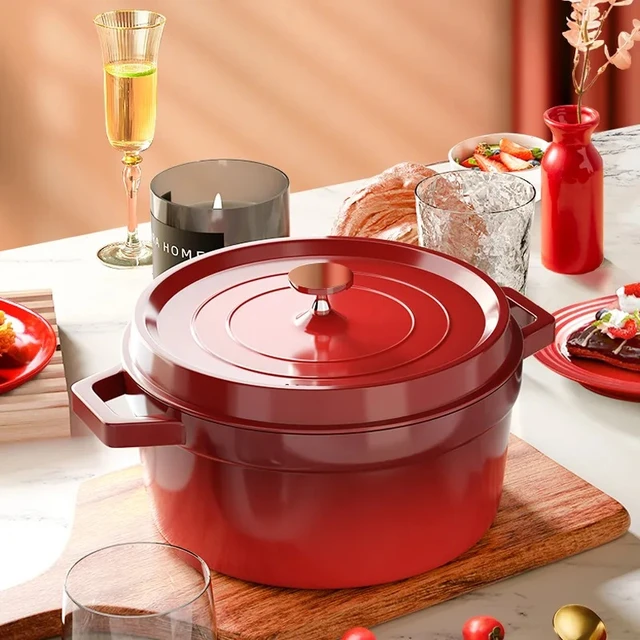Introduction:
Dutch ovens are versatile and durable cooking vessels that have been used for centuries. They are known for their ability to retain and distribute heat evenly, making them ideal for slow cooking, braising, and baking. When it comes to the materials used in the construction of Dutch ovens, several options are available. In this article, we will explore the different materials commonly used to make Dutch ovens, discussing their characteristics, benefits, and considerations. By understanding the material options, users can choose the Dutch oven that best suits their cooking needs and preferences.

What are dutch ovens made of?
Overview of Dutch Ovens:
a. Definition: Dutch ovens are deep, heavy-duty cooking pots with tight-fitting lids. They are typically made of durable materials that can withstand high heat and retain heat effectively.
b. Versatility: Dutch ovens are known for their versatility in the kitchen. They can be used for a wide range of cooking techniques, including slow cooking, braising, stewing, baking, and even frying. Dutch ovens are equally suitable for use on stovetops, ovens, and outdoor cooking setups.
Cast Iron Dutch Ovens:
a. Cast Iron Construction: Cast iron Dutch ovens are a popular choice due to their excellent heat retention and distribution properties. They are made by pouring molten iron into a mold and then allowing it to cool and solidify.
b. Benefits of Cast Iron: Cast iron Dutch ovens are highly durable, able to withstand high temperatures and long cooking times without warping. They provide even heat distribution, which helps prevent hot spots and ensures consistent cooking results. Cast iron also develops a naturally non-stick surface over time when properly seasoned.
c. Considerations: Cast iron Dutch ovens can be quite heavy, which may make them challenging to handle, especially when filled with food. They require regular seasoning and proper care to maintain their non-stick surface and prevent rust. Additionally, cast iron Dutch ovens should not be exposed to drastic temperature changes to avoid thermal shock.
Enameled Cast Iron Dutch Ovens:
a. Enameled Construction: Enameled cast iron Dutch ovens feature a cast iron core with a smooth enamel coating on both the interior and exterior surfaces. The enamel is made from powdered glass that is melted onto the cast iron and then cooled to create a durable, non-reactive, and colorful finish.
b. Benefits of Enameled Cast Iron: Enameled cast iron Dutch ovens offer the same excellent heat retention and distribution as regular cast iron ovens. The enamel coating provides a non-reactive cooking surface that doesn’t impart any metallic flavors to the food. It also eliminates the need for seasoning and makes cleaning easier.
c. Considerations: Enameled cast iron Dutch ovens tend to be more expensive compared to regular cast iron ovens. The enamel coating can chip or crack if mishandled or exposed to extreme temperature changes. While the enamel surface is generally non-stick, it may not be as durable as a well-seasoned cast iron surface.
Stainless Steel Dutch Ovens:
a. Stainless Steel Construction: Stainless steel Dutch ovens are made from a durable alloy that combines iron with other elements like chromium and nickel. The resulting material is corrosion-resistant, non-reactive, and easy to clean.
b. Benefits of Stainless Steel: Stainless steel Dutch ovens are lightweight compared to cast iron ovens, making them easier to handle. They heat up quickly and distribute heat evenly throughout the cooking process. Stainless steel is non-reactive, which means it won’t interact with acidic or alkaline ingredients, allowing for versatile cooking options.
c. Considerations: Stainless steel has lower heat retention compared to cast iron, which may result in slightly less even cooking. A thick aluminum or copper base can be added to the stainless steel Dutch oven to enhance heat distribution. However, stainless steel Dutch ovens with these additional layers are generally more expensive.
Other Considerations:
a. Handles and Knobs: Dutch ovens often have handles and knobs made of materials such as cast iron, stainless steel, or heat-resistant plastic. Ensure that these components are designed to withstand high temperatures and provide a secure grip.
b. Lid Construction: The lid of a Dutch oven should fit tightly to trap heat and moisture. It can be made of the same material as the rest of the Dutch oven or have a different construction, such as a tempered glass lid with a stainless steel rim.
c. Multi-Material Dutch Ovens: Some Dutch ovens combine different materials, such as cast iron with a stainless steel lid or base. These multi-material Dutch ovens aim to provide the benefits of both materials, such as excellent heat retention and even cooking.
d. Brand and Quality: The brand and quality of the Dutch oven can also impact its performance. It is advisable to choose reputable brands known for their craftsmanship and quality materials.
Conclusion:
Dutch ovens are versatile cooking vessels that come in various materials, each with its own benefits and considerations. Cast iron Dutch ovens offer excellent heat retention and even cooking but require regular seasoning and maintenance. Enameled cast iron Dutch ovens provide a non-reactive cooking surface and easier cleaning. Stainless steel Dutch ovens are lightweight, non-reactive, and heat up quickly. Copper Dutch ovens offer precise temperature control and exceptional heat distribution. When choosing a Dutch oven, consider factors such as heat retention, reactivity with ingredients, ease of cleaning, and personal preferences. By understanding the different materials and their characteristics, users can select a Dutch oven that best suits their cooking needs and preferences.




